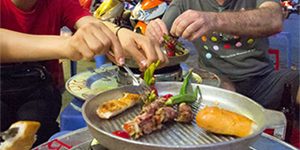What to eat

A quick glance at the book “1000 places to see before you die” may give you many common names denoting exciting and worth-to-visit addresses. As wandering around the ancient town Hanoi, you will have golden chance to come to one place on the list called “Cha Ca” or “Cha Ca La Vong” (La Vong grilled fish pies).
“Cha Ca La Vong” is both the name of a specialty and a famous eatery in Hanoi. In the past, each street was named after the most common goods sold there. In fact, Cha Ca La Vong is the only restaurant to serve this kind of dish along the street but thanks to its outstanding quality and people’s favor, Cha Ca Street is still being used until now. Idyllically located on the house no.14, Cha Ca La Vong is day-by-day attracting higher number of the local and tourists to come.
1. Cha Ca- a tradition
If there has any competition for the oldest restaurant in Hanoi, Cha Ca La Vong definitely comes as a big candidate. It is said that the restaurant was originally built over a century ago; however, the cooking tip is transferred from generation to generation in the family only. La Vong is the name of a real Chinese figure called Khuong Tu Nha or Jiang Ziya who kept fishing and waiting for great opportunity to help the country.
2. A dish can be enjoyed in various ways
The two key ingredients include fish fillets and shrimp paste. Fish is deeply dipped in the marinade; meanwhile, shrimp paste is pre-treated so that everyone, even overseas travelers can give it a try. La Vong grilled fish pies are traditionally served with rice noodle.
People may choose to eat rice noodle, fish and other additives separately. Others may combine all ingredients in their bowl and then spreading hot water in the pot. During winter days, the latter keeps your dish warm enough during the meal.
Please note that you should not miss out adding some Vietnamese herbs in your bowl to lessen lipit level and balance flavors in the dish as well.
3. Some notes before eating
It is recommended that you not eat the dish as suffering from cardiovascular-related diseases due to high volume of cholesterol in the dish.




